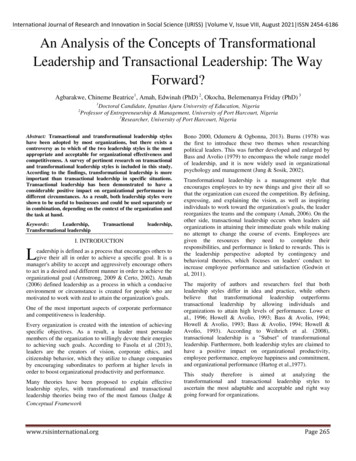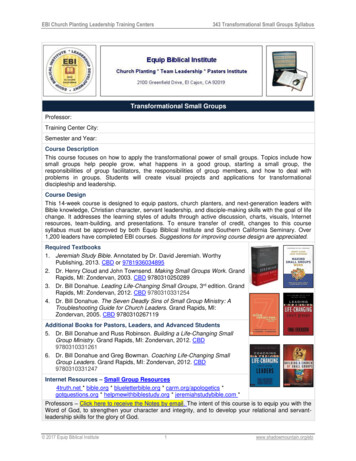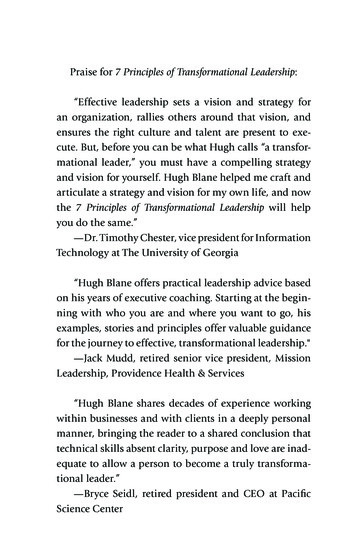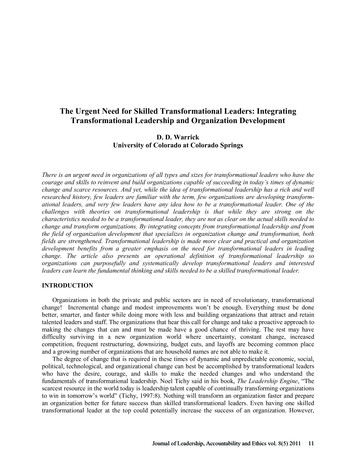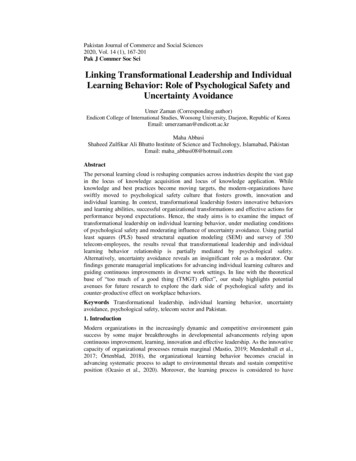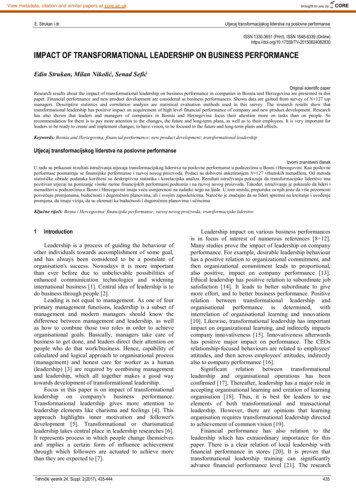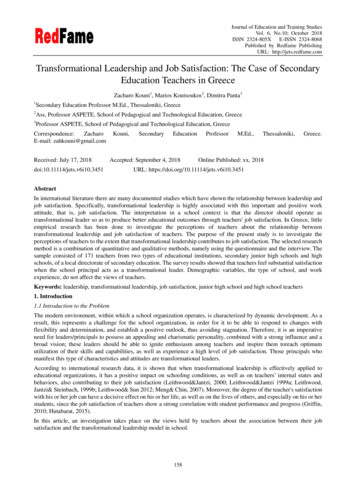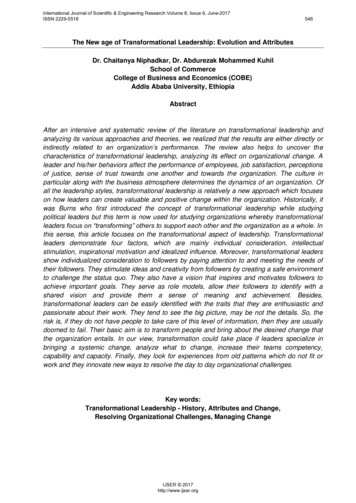
Transcription
International Journal of Scientific & Engineering Research Volume 8, Issue 6, June-2017ISSN 2229-5518546The New age of Transformational Leadership: Evolution and AttributesDr. Chaitanya Niphadkar, Dr. Abdurezak Mohammed KuhilSchool of CommerceCollege of Business and Economics (COBE)Addis Ababa University, EthiopiaAbstractAfter an intensive and systematic review of the literature on transformational leadership andanalyzing its various approaches and theories, we realized that the results are either directly orindirectly related to an organization’s performance. The review also helps to uncover thecharacteristics of transformational leadership, analyzing its effect on organizational change. Aleader and his/her behaviors affect the performance of employees, job satisfaction, perceptionsof justice, sense of trust towards one another and towards the organization. The culture inparticular along with the business atmosphere determines the dynamics of an organization. Ofall the leadership styles, transformational leadership is relatively a new approach which focuseson how leaders can create valuable and positive change within the organization. Historically, itwas Burns who first introduced the concept of transformational leadership while studyingpolitical leaders but this term is now used for studying organizations whereby transformationalleaders focus on “transforming” others to support each other and the organization as a whole. Inthis sense, this article focuses on the transformational aspect of leadership. Transformationalleaders demonstrate four factors, which are mainly individual consideration, intellectualstimulation, inspirational motivation and idealized influence. Moreover, transformational leadersshow individualized consideration to followers by paying attention to and meeting the needs oftheir followers. They stimulate ideas and creativity from followers by creating a safe environmentto challenge the status quo. They also have a vision that inspires and motivates followers toachieve important goals. They serve as role models, allow their followers to identify with ashared vision and provide them a sense of meaning and achievement. Besides,transformational leaders can be easily identified with the traits that they are enthusiastic andpassionate about their work. They tend to see the big picture, may be not the details. So, therisk is, if they do not have people to take care of this level of information, then they are usuallydoomed to fail. Their basic aim is to transform people and bring about the desired change thatthe organization entails. In our view, transformation could take place if leaders specialize inbringing a systemic change, analyze what to change, increase their teams competency,capability and capacity. Finally, they look for experiences from old patterns which do not fit orwork and they innovate new ways to resolve the day to day organizational challenges.Key words:Transformational Leadership - History, Attributes and Change,Resolving Organizational Challenges, Managing ChangeIJSER 2017http://www.ijser.org
International Journal of Scientific & Engineering Research Volume 8, Issue 6, June-2017ISSN 2229-5518547INTRODUCTIONThere are many styles of leadership and their relevance depend upon a specific time period or aparticular situation. Transformational Leadership (TL) seems to be the most apt for the presentday context. Previous studies have consistently shown a positive relationship betweentransformational leadership and effectiveness. However, despite the findings about whattransformational leaders perform, at least one fundamental issue deserves further examinationmore particularly about how do transformational leaders influence an individual follower as wellas a group as a whole and why do followers react to their leaders' leadership behaviors? Aspointed out by several researchers (Bass, 1999; Piccolo & Colquitt, 2006; Yukl, 2006) thesequestions have not been fully addressed when it comes to explaining transformational leadersand transformational leadership. (Cho et al, 2010, p. 409)TL is one of the leadership styles in which leaders and followers are encouraged to motivateothers and bring about the change in an organization whereas transformational leaders mainlyfocus on building a better tomorrow. They are willing to take risks and dig deep in to theunknown. Moreover, they are willing to challenge themselves, their thoughts and put it to actionwhich involves taking risk. Lewis, Goodman and Fandt (1998) believe, in order to make any jobeffective, leaders and followers require several abilities like team-work, effective communication,team spirit, problem solving and aspects of transformational leadership. TL starts with thedevelopment of a vision. Something that is on the way, yet to happen, is anticipated by thetransformational leader. Transformational leadership phenomena need to be examined with amulti-level perspective in order to give us a better understanding of their impacts incontemporary organizations. For example, in current business practices, more and moreindividuals work in team or group-based structures. (Cho et al, 2010, p. 410)The impact that transformational leadership has on members of an organization can be bestexamined by comparing it to transactional leadership, where leaders approach followers with aneye to exchanging one thing for another. (Burns, 1978, p. 3) For instance, exchanging work on aproject for a raise in compensation. Instead, a transformational leader mobilizes his or herfollowers toward reform by an appeal to values and emotions. Bennis and Thomas (2004)believed that great leaders possess mainly four essential traits. They discovered these happento be the same that allows a person to find meaning which could be termed as a devastatingexperience. First, is the ability to engage others in shared meaning, then secondly being adistinctive and compelling voice. Third is a sense of integrity; this implies having a strong set ofvalues. Finally, the most critical skill is the adaptive capacity. This is, ideally applied creativity. Itis a magical ability to transcend adversity and emerge stronger than before. It has two basicqualities; the ability to grasp context and hardiness. The ability to grasp context implies an abilityto weigh a welter of factors, ranging from how very different groups of people will interpret agesture to being able to put a situation in perspective. Without this, leaders are utterly lost,because they cannot connect with their constituents. (Bennis et al, 2004, p. 68)Transformational approaches to leadership have a wide range of potential benefits.At the organization level, transformational leadership practices can produce strategicorganizational change (Waldman, Javidan, & Varella, 2004). Perceived transformational actionshave also been shown to alter staff perceptions of EBPs in mental health service settings(Aarons, 2006) increase staff satisfaction (Judge & Piccolo, 2004), reduce stress and burnout(Seltzer, Numerof, & Bass, 1989) and reduce turnover intentions (Bycio, Hackett, & Allen, 1995;Martin & Epitropaki, 2001). While limited research has linked transformational leadership directlywith client outcomes (such as treatment engagement) staff perceptions have implications forIJSER 2017http://www.ijser.org
International Journal of Scientific & Engineering Research Volume 8, Issue 6, June-2017ISSN 2229-5518548clients. For instance, lower staff burnout has been associated with higher counselor rapportratings among clients within substance use treatment organizations (Garner et al, 2007).Currently there are a number of instruments available that measure transformational leadership,for example the one suggested by Bass & Avolio (1995). However, some important components(such as empowerment), are not routinely assessed. Additionally, most existing instrumentsinclude scales with only one or two marker items that reflect important themes within a corecomponent. This approach works well when assessing a global construct of coretransformational components, but is inadequate when examining components in greater detailfor self-assessment and training purposes. Furthermore, the most commonly used and mostcomprehensive measures of transformational leadership such as the “Multifactor LeadershipQuestionnaire” are available (Bass & Avolio, 1994).Knowing what is happening and anticipating the actions needed for tomorrow is the fundamentalquality to transform or change. In this sense, the first practice is to ask what needs to be done.Note that the question is not “What do I want to do?” it is asking “what has to be done?” anddoing it meticulously. Drucker believes this is very crucial for managerial success. He furtherholds that failure to ask this question will render even the ablest executive ineffectual. (Drucker,2004, p.16) Transformational leadership inspires people to achieve unexpected or remarkableresults. It gives workers autonomy over specific jobs, as well as the authority to make decisionsonce they have been trained. Some of the basic characteristics of transformational leadershipare inspirational, in that the leader can inspire workers to find better ways of achieving a goalmobilization because leadership can mobilize people into groups that can get work done, andboost their morale through excellent rapport. They are also good at conflict resolution. (Rooke etal, 2004)Transformational leaders possess some kind of crucible; a single-minded needs to streamline orchange things that no longer work. The transformational leader motivates workers andunderstands how to form them into integral units that work well with others. (Rooke et al, 2004).This review focuses on the historical development of the concept and the qualities of thetransformational leader.HISTORY OF TRANSFORMATIONAL LEADERSHIPThe term “transformational leadership” was coined by sociologist Downton in 1973. Leadershipexpert Burns defined transformational leaders as those who seek to change existing thoughts,techniques and goals for better results. Referring to transformational leaders he further added,they are the ones who focus on the essential needs of the followers. Transformational leadersexcel in a variety of sectors.Bass (1985) carry forward Burns (1978) work and explained the psychological mechanismsfrom his view point. He discussed about transforming and transactional leadership, in particularand he put emphasis on the term “transformational” instead of “transforming.” Transactionalleadership refers to the exchange relationship between leader and follower to meet their ownself-interests. (Bass, 1999, p.10) He supported the TL idea of Burns (1978) in reference to howit (transformational leadership) could be measured and how it could impact follower‟s motivationand performance. This focuses on the extent to which a leader is transformational which ismeasured first, in terms of his influence on the followers. Furthermore, the followers of such aleader feel trust, admiration, loyalty and respect for the leader and because of the qualities ofthe transformational leader, then followers are willing to work harder than originally expected.These outcomes happen because the transformational leader provides followers somethingIJSER 2017http://www.ijser.org
International Journal of Scientific & Engineering Research Volume 8, Issue 6, June-2017ISSN 2229-5518549more. They give followers with an inspiring mission and vision and give them a unique identity.The leader transforms and motivates followers through his (or her) charismatic influence (alsoreferred to as charisma), intellectual stimulation and individual consideration. Moreover, the(transformational) leader encourages followers to come up with new innovative ways andchallenge the status quo allowing altering the business environment and as per the need of thehour and thus be successful. However, unlike Burns, Bass suggests that leadership cansimultaneously display both transformational and transactional leadership. (Bass & Avolio,1994)TL is an approach that causes change in individuals and social systems. In its ideal form, itcreates valuable and positive change in the followers with the end goal of developing followersinto leaders. Enacted in its authentic form, transformational leadership enhances the motivation,morale and performance of followers through a variety of mechanisms. These includeconnecting the follower's sense of identity and self to the mission and the collective identity ofthe organization; being a role model for followers that inspires them; challenging followers totake greater ownership for their work, and understanding the strengths and weaknesses offollowers, so the leader can align followers with tasks that optimize their performance. (Drucker,2004)METHODSThe question of how to bring together and interpret research studies that are independent fromone another is a basic and important question in all sciences. The inadequacy of the results of asingle study and the need to synthesize findings by scientists has led to the development ofmethodologies that allow for combining the results of many Independent studies. Many methodshave been used to synthesize the findings of multiple studies. Systematic review and metaanalysis are two approaches aimed at synthesizing different studies that are independent of oneanother but also compatible. This review is the result of systematically investigating appropriatescholarly data bases such as Google scholar, JSTOR, Emerald, EBSCO and so on.ATTRIBUTES OF TRANSFORMATIONAL LEADERS’ IN TODAY’S ORGANIZATIONSTL can be found at all levels of the organization more particularly in teams, departments,divisions and in the organization, at large. Such leaders are visionary, inspiring, daring, risktakers and thoughtful thinkers. They have a charismatic appeal. But charisma alone is notsufficient for changing the way an organization operates. Bennis holds that leadership is thecapacity to translate vision into reality. (Bennis et al, 2004)For bringing the key changes, our investigation reveals that transformational leaders shouldpossess the following attributes:1.Inspirational Motivation: The foundation of transformational leadership is the promotion ofconsistent vision, mission, and a set of values to the members. Their vision is socompelling that they know what they want from every interaction. Transformational leadersguide followers by providing them with a sense of meaning and challenge. They workenthusiastically and optimistically to foster the spirit of teamwork and commitment.2.Intellectual Stimulation: Such leaders encourage their followers to be innovative andcreative. They encourage new ideas from their followers and never criticize them publiclyfor the mistakes committed by them. The leaders focus on the “what” in problems and doIJSER 2017http://www.ijser.org
International Journal of Scientific & Engineering Research Volume 8, Issue 6, June-2017ISSN 2229-5518550not focus on the blaming part of it. They have no hesitation in discarding an old practice setby them if it is found ineffective.3.Idealized Influence: They believe in the philosophy that a leader can influence followersonly when he practices what he preaches. The leaders act as role models that followersseek to emulate. Such leaders always win the trust and respect of their followers throughtheir action. They typically place their followers‟ needs over their own, sacrifice theirpersonal gains for them and demonstrate high standards of ethical conduct. The use ofpower by such leaders is aimed at influencing them to strive for the common goals of theorganization.4.Individualized Consideration: Leaders act as mentors to their followers and reward themfor creativity and innovation. The followers are treated differently according to their talentsand knowledge. They are empowered to make decisions and are always provided with theneeded support to implement their decisions. According to Bass (1985), an individuallyconsiderate leader recognizes individual differences in terms of a follower's particularneeds and expectations and provides individualized support for the development of thefollower. This type of leader, acting as a coach or mentor, guides his or her follower usingempowering behaviors that correspond with the follower's particular needs. In addition,such supporting behaviors are delivered to the follower in a friendly, close, and equalmanner (Bass, 1985). As the concept of individualized consideration implies, it is highlylikely that a leader's support will vary among different followers depending on their differingcapabilities and needs. Also, each follower could have different perceptions of the leader'sbehaviors (Bass & Avolio, 1998), based on individual personality differences (Yammarino,Dansereau, & Kennedy, 2001). As a consequence, a transformational leader'sindividualized consideration within this study is conceptualized at the individual level. (Choet al, 2010, p. 410)Of these four aspects, mentioned above, idealized influence is the most appreciated. However,transformational leaders develop their own leadership capacity by motivating their followers toachieve extraordinary outcomes. They help the followers to grow and develop the leadership inthem by responding the unique needs. These leaders empower their followers with smartobjectives and goals of the followers. Any organization requires a leader whom the followerscan trust and help each other for the development to a higher level of morale and motivation; aleader who propel the organization forward. Transformational leadership involves a committedrelationship between the leader and his followers. (Bass and Riggio, 2008) As a result,transformational leaders are often given management positions in companies since they areknown for the ability to develop a vision and inspire others to follow them towards it.Transformational leaders are viewed as charismatic and able to motivate followers to achievegoals that exceed expectations through vision and motivation. In contrast, transactional leadersalso reward followers for performance but do not intervene unless goals are not being met.Thus, the main challenges presented by transformational and transactional leadership aresimilar to the problems of measuring leadership behaviours of Path-Goal and Vertical DyadLinkage theories. In addition, the dynamics of the charismatic element of transformationalleadership are difficult to conceptualize and measure. Charismatic leadership has beendescribed by examples of charismatic leaders and in terms of the stages or process ofcharismatic leadership; but the dynamics between charismatic leaders and followers requirefurther clarification. The transformational leadership style draws on assorted capabilities andapproaches to leadership, creating distinct advantages for the organization. A leader using thisIJSER 2017http://www.ijser.org
International Journal of Scientific & Engineering Research Volume 8, Issue 6, June-2017ISSN 2229-5518551approach possesses integrity, sets a good example and clearly communicates his goals to hisfollowers. He expects the best from them. He inspires people to look beyond their own interestsand focus on the interests and needs of the team. He provides stimulating work and takes thetime to recognize good work and good people. Furthermore, any attempt to developtransformational leadership must acknowledge the organizational realities of other styles ofleadership. This is one of the key strengths of the full range leadership model. It explicitlyacknowledges that managers are likely to use a whole palate of styles ranging from the nontransactional, through transactional to transformational. (Kirkbride, 2006, p.31)For effective leadership among teams, according to us, transformational leaders should be:1. Very well-organized and expect their followers to be creative.2. Team-oriented and expect that followers will work together to create the best possibleresults.3. Able to give and get respect.4. Taking full responsibility of their team.5. Acting as coach or mentor. In this sense, they should provide training and motivation toreach the desired goals.6. Having the ability to influence followers to bring about a positive change within theorganization.TL‟s aspect of formulating a vision makes it unique from other leadership styles. Doing so, alsoenables to quickly assess the organization‟s current situation and create a suitable strategy forits growth. In this sense, transformational leaders communicate their visions properly andcommunicate at all levels effectively. This characteristic also helps transformational leaders todeal smoothly during calamity and remain focused; allowing every employee to see the bigpicture than complaining on small issues. Furthermore, this leadership style creates anenthusiastic environment and encourages creativity and innovation at work. When employeeswork with self-confidence, self-motivation and collective vision, such an approach guaranteesthem higher level of efficiency and maximum output. Besides, transformational leaders beingpassionate about their job, get people to work and thus optimize performance.During difficult times, transformational leaders normally rely on their inner instinct and guideemployees in the right direction. Additionally, when it comes to the management decisionmaking, strategy formation, TL ideally contributes to create, motivate, develop and build theorganization and its people. The following steps are involved:Step 1: Create an Inspiring Vision – Vision of the Future.Step 2: Motivate Teams to Engage and Deliver – Teams to Engage and Deliver upon theVision.Step 3: Develop Clear Operational Strategies – Strategies that are easily executable.Step 4: Build Strong, Relationship-Based Cultures – Cultures that are rock solid.Yukl (1999) offers easy tips to new age of transformational leaders. They are as follows:1.2.3.Develop a challenging and attractive vision, together with the employees.Tie the vision to a strategy for its achievement.Develop the vision, specify and translate it to actions.IJSER 2017http://www.ijser.org
International Journal of Scientific & Engineering Research Volume 8, Issue 6, June-2017ISSN 2229-55184.5.552Express confidence, decisiveness and optimism about the vision and its implementation.Realize the vision through small planned steps and small successes in the path for its fullimplementation.CONCLUSIONThe question of how to bring together and interpret research studies that are independent fromone another is a basic and important question in all sciences. The inadequacies of the results ofa single study and the need to synthesize findings by scientists have led to the development ofmethodologies that allow for combining the results of many Independent studies. Many methodshave been used to synthesize the findings of multiple studies. Systematic review and metaanalysis are two approaches aimed at synthesizing different studies that are independent of oneanother but also compatible.Transformational leadership is based on the assumption that people will “follow” or work for ordo great things for a person who inspires them. A person with vision and passion can achievegreat things, and the way to get things done is by instilling people with enthusiasm and energy.Transformational leadership starts with the development of a vision, a view of the future that willexcite potential followers. The next step, which in fact never stops, is to constantly sell thevision. This takes energy and commitment, as few people will immediately buy into a radicalvision, and some will join more slowly than others. The Transformational Leader thus takesevery opportunity and will use whatever works to convince others to join with him or her in thequest to get the job done. The main criticism of Transformational Leadership is that the passionand confidence of the leader can easily be mistaken for truth and reality. It is true that greatthings have been achieved through enthusiastic leadership, but it is also true that manypassionate people have led the charge right over the cliff and into a bottomless chasm. Justbecause someone believes they are right, it does not mean they are right.Paradoxically, the energy that gets people going can also cause them to give up.transformational leaders often have large amounts of enthusiasm which, if relentlessly applied,can wear out their followers. Another criticism of Transformational Leadership is thattransformational leaders tend to see the big picture, but not the details, where the devil oftenlurks. If they do not have people to take care of this level of information, then they might meetfailure. Finally, Transformational Leaders, by definition, seek to transform. When theorganization does not need transforming and people are happy as they are, then such a leaderwill be frustrated. Like wartime leaders, however, given the right situation they come into theirown and can be personally responsible for saving entire companies.Today‟s business environment is surrounded by uncertainty, global turbulence andorganizational instability. This calls for a new age leadership in order to triumph at all levels forthe organization. The organization and its people need to change and transform to the changingscenario. „Transformational Leadership‟ is undoubtedly the answer. It is a key to success and apathway to supersede business challenges. Transformational leaders demonstrate high levelsof job satisfaction and organizational commitment. They show the organizational citizenshipbehaviours and feel accountable not just for their work but for their organization like a patriotthinks for his nation. Bernard Bass‟s article offers a good synthesis of what we have learned andwhat remains to be learned about the transformational leadership workings. However, progresswill be achieved only if theory building efforts lead to precise hypotheses to be tested. In thiscommentary, I focused on five areas of needed research namely, (1) construct validation (theIJSER 2017http://www.ijser.org
International Journal of Scientific & Engineering Research Volume 8, Issue 6, June-2017ISSN 2229-5518553linkage between a construct and its measurement), (2) personality attributes of transactionaland transformational leaders, (3) effects of training in transformational skills on organizationaloutcomes, (4) contextual influences, and (5) the search for mediators. (Bass, 1999, p.31)Our research suggests that transformation could take place if leaders specialize in bringing asystemic change, knowing what change is required, maximizing their teams‟ competency,capability and capacity, look for experiences from old systems and methods that do not fit orwork in the present scenario so they innovate new ways to resolve the day to day organizationalchallenges. Besides, the transformation from being an expert to achiever is the most commonlyobserved and practiced among businesspeople and by those in management and executiveeducation. (Rooke et al, 2004) For more than two decades, training departments especially ofcorporates have been supporting the development of managers to transform from experts intoachievers by running programs like “Management by Objectives” (also commonly referred asMBO) “Effective Delegation” and “Managing People”, “Leadership Development Program” (alsocommonly referred as LDP) and many others. These programs typically emphasize gettingresults through building flexible strategies and make trainees learn the ability to change peopleand situations according to the need of the hour in favor of the organization.IJSER 2017http://www.ijser.org
International Journal of Scientific & Engineering Research Volume 8, Issue 6, June-2017ISSN 30.31.32.33.34.35.Aarons, G.A. (2006). Transformational and Transactional Leadership: Association with Attitudes TowardEvidence-Based Practice. Psychiatric Services. Volume 57, Issue 8, August, 2006, pp. 1162-1169.Alimo-Metcalfe, B. & Alban-Metcalfe, J. (2001). „The development of a new Transformational LeadershipQuestionnaire‟. The Journal of Occupational & Organizational Psychology, 74, 1-27Allio, R. (2012). Leaders and leadership many theories but what advice is reliable? Strategy and Leadership,Vol. 41 Issue 1pp. 4-14.Anderson, K. D. (2008). Transformational teacher leadership in rural schools. The Rural Educator, 8-17.Avolio, B.J. (1999). Full Leadership Development, Sage, Thousand Oaks, CA.Balyer, A. (2012). Transformational Leadership Behaviors of School Principals: A Qualitative ResearchBased on Teachers‟ Perceptions. International Online Journal of Educational Sciences, 4 (3), 581-591Bass, B. M. & Riggio, R. E. (2008). Transformational Leadership. Mahwah, New Jersey: Lawrence ErlbaumAssociates, Inc.Bass, B. M. (1985). Leadership and Performance, N.Y. Free Press.Bass, B. M. (1998). Transformational leadership: Industrial, military, and educational impact. Mahwah, NJ:Erlbaum.Bass, B. M. (1999). Two Decades of Research and Development in Transformational Leadership. EuropeanJournal of Work and Organizational Psychology, 8(1), 9-32.Bass, B.M. & Avolio, B.J. (Eds.). (1994). Improving organizational effectiveness through transformationalleadership. Thousand Oaks, CA: Sage Publications.Bass, B.M. (1990). Bass and Stogdill‟s Handbook of Leadership: Theory, Research and ManagerialApplications, 3rd ed., Free Press, New York, NY.Bass, B.M. (1999). Two decades of research and development in transformational leadership, EuropeanJournal of Work and Organizational Psychology, Vol. 8 No. 1, pp. 9-32.Bass, B.M. and Avolio, B.J. (1998). Manual for the Multifactor Leadership Questionnaire, Mindgarden, Inc.,Redwood, CA.Bennis, W. and Thomas, R. (2004). Crucibles of Leadership. Harvard Business Review. January issue.Brower, R. E., and Bal
Transformational Leadership (TL) seems to be the most apt for the present day context. Previous studies have consistently shown a positive relationship between transformational leadership and effectiveness. However, despite the findings about what transformational leaders perform, at least one fundamental issue deserves further examination .

